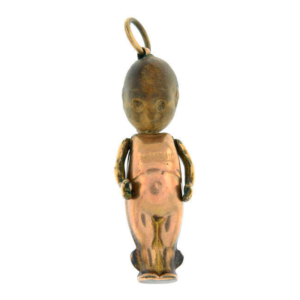We all recognise the four-leaf clover as a sign for good luck, and we cross our fingers to each other to share our hopes for good fortune, but the late nineteenth-century ‘fumsup’ character is a good luck motif that has slipped from our everyday use. However, with its combination of both the ‘thumbs up’ and the ‘touch wood’ sentiments, the fumsup charm could be our luckiest!
The Fumsup Charm
The fumsup character took shape in Victorian Britain. The metal, articulated figure of an infant typically had a rounded wooden head that it could touch when its arms were raised. This movement linked the charm to the phrase ‘touch wood’. This phrase had developed as a sentiment to ward off ill fortune and to look forward to good fortune. The origins of the touch-wood phrase are unknown. It was already a common saying by the late nineteenth century when the fumsup charm emerged. Other touch-wood charms, particularly from the 1950s, can be found on the secondary market today, They all feature a wooden ball or element that forms the body of metal motifs. They can be found in the shape of pigs, rabbits, mice, pixies, and teapots.
The fumsup charms take the touch-wood sentiment one step further than the wooden ball charms. The hands of the infant’s articulated arms are shaped in the thumbs-up gesture as an additional sign of goodwill. The history of the thumbs-up sign is also vague. It was believed that a Roman emperor could pardon and spare a defeated gladiator by giving a thumbs-up gesture. The likelihood of this practice has since been questioned. It is likely that the Victorians enjoyed the classical link to good fortune.
The Rise of the Fumsup
Fumsup charms rose in popularity during the First World War. Loved ones would gift soldiers the little charm before they left to fight. The small size but loaded meaning of charms made them ideal gifts for soldiers to carry discreetly with them. Jewellery and giftware companies were quick to capitalise on their popularity. The fumsup charm could be bought in brass, silver, 9-carat gold, 15-carat gold and 18-carat gold, and with or without gem-set eyes. The infant character also became a go-to design for use on postcards and playing cards. Other charm motifs included lucky numbers, hearts and lucky white heather.
Though the fumsup character experienced a dip in prevalence, it is resurging as a collector’s item. Its sentimental and lucky nature make it an enticing and accessible element of First World War history.
Fumsup Charms at Auction

Tuesday 2nd November 2021
Lot 78
An early 20th-century gold Fumsup charm.
Price Realised £133.98












